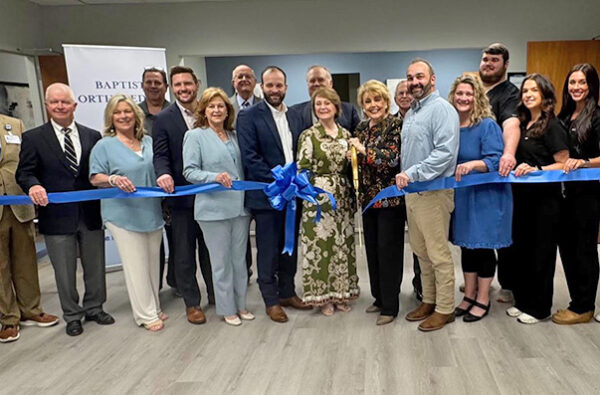The Baptist Nursing and Clinical Advisory Council (NAC) is composed of a special group of team members dedicated to making things easier and more efficient for our clinicians – especially nurses – by helping to reduce their electronic workload, which can allow for more time with patients. Many members of NAC (pronounced “knack”) have been devoted to the cause since 2013!
Let’s learn more about NAC via our conversation with its co-facilitators, Lauren Yates, system nursing director, and Chad Sanders, nursing informatics at NEA Baptist in Jonesboro, Arkansas.
Would you tell us more about NAC?
Lauren Yates
Since we adopted Epic, NAC members have been working behind the scenes to serve as the bridge between the Baptist OneCare (BOC) project team and nursing and interdisciplinary care providers using Epic.
In my mind, they are one of the front-running groups to adopt a “system-ness” frame of mind. They have worked hard at focusing on solutions and decisions that primarily benefit patient care and the organization, rather than individual or entity preferences.
How did you become part of NAC?
Lauren Yates
Epic required us to develop a Nursing and Clinical Advisory Council to establish a governance structure and participate in build and implementation. I was asked to serve as the nurse champion for our Epic implementation and the facilitator for NAC.
Chad Sanders
I had the opportunity to join in early 2016. I loved the idea of being the liaison between frontline staff and the group that had the influence and governance to make the electronic health record (EHR) and the work better. And that’s been my passion.
Who can become a part of NAC?
Chad Sanders
CNOs from each entity appoint representatives to be a part of NAC.
Lauren Yates
And it is an honor to be selected. The person chosen is someone who is engaged, high-performing and trusted by their peers.
Also, it’s interdisciplinary. From the very beginning, we tapped representation from ancillary disciplines and system group leads. We have members representing system respiratory, system laboratory, system therapy and system pharmacy.
It is my honor to present the current members of NAC who work alongside me and Chad:
- Hope Rodgers – Attala
- Jana Crittenden, Nicole Pounders, Karen Galinsky – Golden Triangle
- Michael Cupples – Carroll County
- Jeff Edwards, Jessica Hudgins – Collierville
- Shawn Elliott, Cara Beard – Crittenden
- Latasha Woods, Stephanie Patterson – DeSoto
- Nicole Bailey, Dawn Davis, Julie Prisock, Diane Shaw – Mississippi Baptist Medical Center
- James Bolden – System Lab
- Larry Hopper – System Respiratory
- Brett Walker, Amelia Sisk, Trudy Henze, Nicki Staples, Shenell Thompkins – Memphis
- Susan Arwood – Case Management
- Tabetha Polly – Therapy
- Emilee Malone – NEA
- Leigh Laughter, Carol Garner – Oxford
- Cassandra Wakefield, Crystal Poole – Tipton
- Gina Horne – System OB
- Melita Wilbanks, Justin Armstrong – Women’s
- Katherine Presley – Yazoo
- Leslie Gordon, Yvette Cappello – Restorative
- Fiona Howell, George Grimes – Booneville
- Jahnae Smothers – Union City
- Teresa Ervin, Kelsey Knoch – System Pharmacy Reps for NAC
- Michael Johnston – Leake
- Jillian Foster, Keesha Medley, Missy Arwood, Marianne Ivie, Stacy Hammett, Dr. Jake Lancaster – Corporate
What are the goals of NAC?
Lauren Yates
To provide oversight and critical evaluation for change or optimization requests, make recommendations based on evidence, and prioritize change implementation so BOC knows what to work on first. And we have a framework that we use to prioritize these decisions based on whether they are regulatory-related or related to patient safety or patient experience.
For the last few months, we have been almost exclusively focused on exploring every way possible to decrease documentation burden for nursing so that we capture information efficiently while supporting personalized and individualized patient care.
Could you give some examples of changes and improvements made by NAC?
Chad Sanders
We recently approved the removal of 21 different fields from admissions documentation. These fields were available in the EHR, but never or rarely charted on. This meant nurses were routinely scrolling past them to get to other fields that were required or frequently documented on.
Lauren Yates
We approved consolidating and reorganizing options in about 40 fields in another section of the EHR as well. We evaluated the number of Best Practice Advisories (BPAs) that were firing for nurses. BPAs are interruptive alerts that pop up onto your screen.
Without understanding as much as we do now, these BPAs were popping up to the point where we had over a million a month firing for nurses.
You don’t want nurses to get fatigued from seeing so many alerts and get in the habit of dismissing them because they aren’t meaningful. So we asked NAC to help us evaluate each one to see if it was meaningful, if it was doing what we thought it would do.
We’ve reduced those back down to just several thousand a month, which is where we should be. Compared to other Epic customers, we now fire fewer BPAs than a large percentage of hospitals.
What is Project Joy?
Lauren Yates
The examples we just talked about were part of our Project Joy work. NAC members are going to play an integral role in our Project Joy efforts and have communicated they are excited and very committed to doing what it takes to reduce documentation overload.
We bring opportunities to reduce fields or scrolling in the EHR to NAC and ask, “If we moved this section, or removed this section, what would happen? Do you all think this is good? Is it going to affect the ability to document, or the care? Will it give time back to the nurse?”
Nurses didn’t become nurses to document. They became nurses to provide care to patients. We don’t want to keep them away from patients to get documentation done.
What are the responsibilities of NAC members?
Lauren Yates
There are five roles and responsibilities of NAC:
- Guiding the BOC project team and BOC project executives in making decisions that are congruent with Baptist Memorial Health Care policy
- Reviewing change and enhancement requests and prioritizing evidence-based recommendations based on patient safety needs, regulatory compliance, patient experience enhancement, workflow improvement and financial stewardship
- Exploring ways to decrease the documentation burden and present information efficiently while supporting evidence-based and personalized care
- Prioritizing enhancement and configuration change requests from end users
- Resolving policy debates that arise at the project level during the design and validation process, and establishing clear, consensus-based recommendations on the wisest course of action and preferred alternatives
It’s the critical discussion and decision-making that makes NAC so successful. Everything requires a consensus. There may be one or two people who disagree, but they will listen to what others are saying and defer to the group. It’s been very gratifying to be a part of this group. It really understands the importance of the work.
It’s also good that members of NAC are our first-line champions. If others are nervous about some of the changes, NAC members can help reinforce why the decision was made or bring us feedback that a change we made is having an unintended consequence.
Chad Sanders
I’ll reiterate what Lauren said about the cohesiveness of the group and the ability of the group to express different viewpoints, but, ultimately, come together to support the decision that we make. And we’re OK to go back and revisit something later if we see needs change.
It’s not uncommon for the same type of request to come back around several months later, and we reevaluate and ask if the decision we made is still the right decision for the organization.
Lauren Yates
And I want to add that we’ve talked a lot about the EHR and the decision-making process. But I think, first and foremost, this group keeps the patient at the center of all its work.
Chad Sanders
Absolutely.
Lauren Yates
And a meeting doesn’t go by when somebody doesn’t say, “What will this mean to patient care?” And then after that, “What will it mean to the workload or ease of use?” It’s always about our patients.
How would you say patients benefit from NAC?
Chad Sanders
There are a couple of things that come to my mind, and the first is safety. It’s the first thing we discuss with a request. We always ask, “How does this impact the patient?”
Another way that patients benefit is by the reduction of the workload and cognitive load on the clinician to produce all this documentation. The work of Project Joy to reduce that burden is focused on giving time back to the clinicians to allow them more time with direct bedside care.
Lauren Yates
Also, the work we’re doing with our EHR helps ensure we’re capturing information to accurately communicate the patient story – between disciplines, between visits and between inpatient and outpatient.
Would you like to add anything?
Lauren Yates
NAC members have worked under the radar or behind the scenes since 2013. We want to emphasize their quiet but steadfast contribution and recognize the important work they do.






